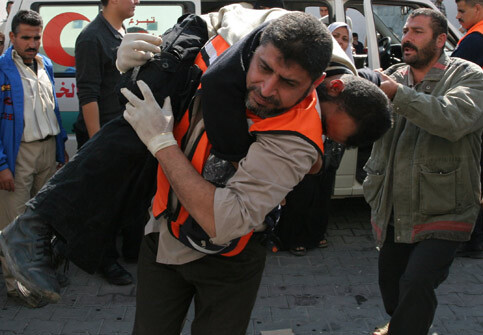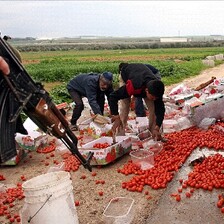Palestine Center 17 November 2006

Palestinian paramedics carry a wounded young man into Beit Lahiya hospital after he was injured during an Israeli military incursion into the northern Gaza Strip town of Beit Hanoun, 3 November 2006. (MaanImages/Wesam Saleh)
Overview: On the morning of 2 November 2006, Israeli military forces seized Palestinian airwaves to declare the Gazan village of Beit Hanoun a closed military zone and order all Palestinians residing in the area to remain indoors. Still recovering from the humanitarian crisis caused by Israel’s June offensive, “Operation Summer Rain,”[i] residents braced themselves for what appeared to be another looming attack on Palestinian civil society. What they didn’t expect, however, was the week-long siege of brutal force and “reckless disregard”[ii] for human life that would eventually claim the lives of nearly 100 Palestinians and injure hundreds more - half of whom were women, children, and other unarmed bystanders.
Beit Hanoun: Adding to the Public Health Crisis
While the stated goal of the Beit Hanoun operation, “Autumn Clouds,” was to “disrupt and prevent the launching of Qassam rockets into the State of Israel,”[iii] the Palestinian Ministry of Health (MOH) described its social consequence as being that of a “massive humanitarian disaster.”[iv] The MOH’s account, corroborated by a myriad of eyewitnesses, including both international observers and media sources, provides evidence of a wide range of human rights violations culminating in what has, in fact, become a public health crisis.
According to the MOH, not only did Israeli forces impose a blockade on Beit Hanoun’s sole medical center - preventing both ambulances and medical teams from reaching victims, but it also subjected hospital personnel to “inhumane interrogations” and fired live ammunition on a medicine stock room - causing members of its already fearful staff to abandon their vital posts.[v] Moreover, the indiscriminate killing of volunteer ambulance personnel Ahmad al-Madhoun, 42, and Mustapha Habib, 26, by an Israeli air strike left emergency rescue teams frightened and distressed while on duty - two factors likely to affect their level of performance.[vi] Adding to this a strictly imposed public curfew, restrictions on transportation and movement, as well as electricity supply issues left in the aftermath of Israel’s June offensive - public health conditions began to deteriorate far worse than ever before.[vii] According to various eyewitness accounts - sewage began flooding the streets, water became unsanitary for consumption, hospital morgues could no longer house the deceased, and medicine that needed to be refrigerated either spoiled or could not be delivered at all.
At a 3 October 2006 Palestine Center briefing, Middle East and North Africa Deputy Director of Human Rights Watch, Joe Stork, explained the effects of the aforementioned electricity supply issues on civilian life in the Gaza Strip: “How do you get water from under the ground? You get it with electric pumps. Once you get it out of the ground - 50 percent of Gazans do not live on the ground floor - it has to be pumped from the street level to where they live. In the end of the day we are talking about the availability of water supplies to Gazans, particularly in urban setting is two hours a day. That is something that has been the case since 28 June and is likely to be the case for about another year.”[viii]
Military Occupation and Economic Boycott: Implication for Public Health
The humanitarian crisis caused by Israel’s siege of Beit Hanoun serves as a microcosm for the broader implications on public health that Israel’s decades-old military occupation continues to impose upon Palestinian civil society.
While Israel’s 2005 unilateral disengagement plan left the Gaza Strip free of illegal settlements and outposts, Israeli restrictions placed on the territory’s airspace, ports, and border crossings - combined with frequent military incursions and an international economic boycott of the Palestinian Authority (PA) - have left it socially and economically devastated. International organizations currently place Gaza’s unemployment and poverty levels at 40 percent (compared to less than 12 percent in 1999)[ix] and 87 percent,[x] respectively.
In the West Bank, a similar situation exists - only with the added obstacle of a draconian permit system restricting the movement of all Palestinians wishing to travel within and out of the Green Line - including medical patients, emergency rescue teams, and other hospital personnel.[xi] Combined with a 40 percent increase in checkpoints and roadblocks (since August 2005),[xii] as well as the socio-geographic inconveniences and devastations caused by the construction of Israel’s Separation Wall,[xiii] accessing healthcare facilities has become literally dependent upon the personalities of individual Israeli soldiers. Where vehicles transporting injured persons, including ambulances, are denied the right of passage - the poor in health are often forced to return to their points of origin or seek medical attention on sight - often in the street.
A 2005 report by Ramallah’s Health, Development, Information and Policy Institute (HDIP) - of which Palestinian Legislative Council Member Dr. Mustafa Barghouthi is founder and director - explains: “The result of these obstacles [has been] the creation of 28 cantons in the West Bank, which encompass 64 Palestinian communities and completely isolate 41 medical clinics. This isolation affects [an estimated] 425,000 Palestinians.” The implications for public health resulting from the Wall’s construction are most evident in Occupied Jerusalem, “[W]here Israel has already begun confiscating [70,000 Palestinians’] IDs and cancelling their health insurance benefits on the grounds that they no longer live in Jerusalem.”[xiv]
According to the Palestinian Health Information Center, an agency of the MOH, between the dates of 28 September 2000 and 20 August 2006, 10 percent of pregnant women in the West Bank and Gaza on route to medical clinics and hospitals to give birth were delayed by Israeli forces for an average of two to four hours. As a result, 68 women were forced to deliver their children at checkpoints. - resulting in the deaths of 4 mothers and 34 newborns.[xv]
Despite a short quip by one of Israeli PM Ehud Olmert’s key advisors, Dov Weissglas, that “[an economic boycott of the Palestinian Authority is] like an appointment with a dietician. The Palestinians will get a lot thinner, but won’t die” - Palestinians are, in fact, dying.[xvi]
As a result of international sanctions on aid, the PA has been unable to compensate many government employees - including the medical staff of state hospitals - since March of 2006. Often striking in protest of these harsh economic conditions, hospital personnel have begun turning away patients - leaving West Bank Palestinians, 56 percent of whom live below the poverty line,[xvii] to either pay the exorbitant fees of private clinics or forgo healthcare all together.
Such realities have resulted in the decrease of medical, food, and clean water supplies; an increase in the price of goods and medical services; as well as the inability to properly treat and/or transport patients to adequate medical facilities. In short, as movement restrictions and attacks on civilian infrastructure continue to worsen, so does public health.
Responsibility and the Call for International Intervention
In an October 2006 statement to the Fourth Committee of the United Nations General Assembly, Commissioner-General Karen Koning AbuZayd referred to the Occupied Palestinian territory as “a part of the world which has become a byword for violations of international law.”[xviii] According to various statutes of international law concerning the responsibilities of occupying powers - most notably found in the Geneva Convention Relative to the Protection of Civilian Persons in Time of War (1949) - Israeli military forces are required to refrain from participating in actions resulting in the collective punishment of civilian populations (Article 33) and destruction of public works facilities (Article 53), as well as adopt “measures of public health and hygiene” for occupied territories (Article 56) and provide protection for all medical personnel (Articles 17 - 23).
Given the devastating implications that the international community’s economic boycott of the Palestinian Authority’s Hamas government have added to the already deteriorating public health conditions of Israeli occupied Palestinian civil society, worldwide nongovernmental organizations are calling for an immediate intervention on behalf of Palestinian human rights.
Nadeem Muaddi is Grants and Accounts Associate at The Jerusalem Fund For Education and Community Development. The above text may be used without permission but with proper attribution to The Palestine Center. This information brief does not necessarily reflect the views of The Jerusalem Fund.
Related Links
Footnotes
i In June of 2006, Israeli military forces invaded Gaza under the pretext of recovering Corporal Gilad Shalit - an Israeli soldier abducted by Palestinian militants for the purpose of conducting a prisoner exchange. After refusing to meet the demands of Corporal Shalit’s captors - mainly the release of hundreds of Palestinian women and children detained in Israeli prisons without charge - Israeli PM Ehud Olmert declared, “We want to create a new equation - freeing the abducted soldier in return for lessening the pressure on the Palestinians.” Dubbed “Operation Summer Rain”, Israeli Defense Forces held the Gaza Strip under a devastating siege of land, air, and sea attacks - targeting vital civilian infrastructure, including roads and factories, as well as a power plant that provided energy to both water pumps and hospitals. By the operation’s completion, hundreds of Palestinians had been killed, injured or displaced, and Corporal Shalit remained captive. (McGreal, Chris. “Israeli Tanks Turn Screw on Besieged Gaza Strip.”. The Guardian, 29 June 2006.)
ii Amnesty International, “Israel/Occupied Territories: Amnesty International delegate visits scene of Gaza Strip Killings.” AI Index: MDE 15/087/2006. News Service No: 288, 8 November 2006.
iii Israel Defense Forces: The Official Website. “IDF Launches Operation in Beit Hanun to Thwart Qassam Rockets Threat.” 1 August 2006.
iv Press Release from the Palestinian Ministry of Health: 2 November 2006.
v Press Release from the Palestinian Ministry of Health: 1 November 2006.
vi See note ii above.
vii “Exacerbating Gaza’s socioeconomic decline was Israel’s attack on Gaza’s only power station last June. The plant, which was destroyed, supplied 45 percent of the electricity in the Gaza Strip. The cuts in power have been extremely harmful to healthcare delivery, food and water supplies, and the treatment of sewage among other problems. Recently, the Israeli human rights group, B’tselem said the attack on the power plant constituted a war crime under international law since it targeted a civilian population.” (Roy, Sara. “The Gaza Economy.” Palestine Center “Information Brief” No. 143, 2 October 2006.
viii Goering, Curt and Joe Stork. “Destruction and Violations: Gaza, Lebanon and Israel.” Palestine Center “For the Record” No. 266, 3 October 2006.
ix See note vii above.
x UNRWA Commissioner-General Karen Koning AbuZayd. Statement to the Fourth Committee of the General Assembly, 31 October 2006.
xi The “Green Line” is the 1949 armistice line differentiating between land conquered by Israel during its “War of Independence” - referred to by Palestinians as “Al-Nakbeh” or “the catastrophe” - and the West Bank.
xii UN News Centre: “Israeli Obstacles to Free Movement in Palestinian Territories Mount, UN Reports.” 12 October 2006.
xiii In a 9 July 2004 Advisory Opinion issued by the International Court of Justice at the Hague, Israel’s Separation Wall was found to be constructed “contrary to international law.” (General List No. 131)
xiv Health, Development, Information and Policy Institute. “Health & Segregation II: The Impact of the Israeli Separation Wall on Access to Health Care Services.” 2005..
xv Gazzar, Brenda. “Palestinian Women Pay Health Toll at Checkpoints.” Women’s eNews. 16 November 2006.
xvi Al-Haq, Intervention to Member States of the United Nations on the Sixth Anniversary of the Second Intifada, 29 September 2006. http://asp.alhaq.org/zalhaq/site/templates/viewArticle.aspx?fname=../ePublications/289.htm.
xvii See note x above.
xviii Ibid.
